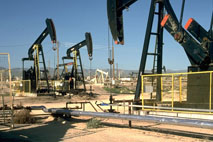Oil Rises Above $134 on U.S. Supply Drop, Bank Price Forecasts
 (Bloomberg) – Crude oil rose to a record above $134 a barrel in New York as U.S. stockpiles unexpectedly dropped and banks raised price forecasts because of supply constraints and demand growth.
(Bloomberg) – Crude oil rose to a record above $134 a barrel in New York as U.S. stockpiles unexpectedly dropped and banks raised price forecasts because of supply constraints and demand growth. Inventories fell 5.32 million barrels to 320.4 million last week, the biggest drop in four months, the Energy Department said yesterday. Oil for December 2016 delivery rose more than $20 a barrel, or 17 percent, after Goldman Sachs Group Inc. on May 16 raised its outlook to $141 a barrel for the second-half of the year.
”What we have here is a situation where essentially higher prices aren’t generating any more supply,” Paul Sankey, an analyst at Deutsche Bank Securities in New York, said in an interview with Bloomberg radio. ”What we have to do is keep pricing the commodity higher until demand starts falling,” which ”is around $150 a barrel.”
Crude oil for July delivery rose $1, or 0.8 percent, to $134.17 a barrel at 9:04 a.m. in Sydney in after-hours trading on the New York Mercantile Exchange. It touched $134.42, the highest since trading began in 1983. Prices have more than doubled in the past year.
Yesterday, crude oil for July delivery rose $4.19, or 3.3 percent, to settle at $133.17 a barrel.
Gasoline futures advanced to a record $3.4234 a gallon. Gasoline for June delivery rose 2.15 cents, or 0.6 percent, to $3.4180 a gallon at 8:25 a.m. Sydney time. Yesterday, it rose 9.21 cents, or 2.8 percent, to settle at $3.3965 a gallon.
Higher Pump Prices
Heating oil for June delivery rose 3.91 cents, or 1 percent, to $3.9475 a gallon, after touching an all-time high of $3.9504. Yesterday, it increased 13.34 cents, or 3.5 percent, to close at $3.9084 a gallon.
Pump prices are following futures higher. Regular gasoline, averaged nationwide, rose 0.7 cent to a record $3.807 a gallon, AAA, the nation’s largest motorist organization, said yesterday on its Web site.
An inventory increase of 300,000 barrels was forecast, according to the median of responses by 15 analysts surveyed by Bloomberg News before the inventory report’s release.
The supply decline left stockpiles 0.9 percent below the five-year average for the week, the Energy Department said. Supplies were 0.8 percent above normal a week earlier.
Imports fell 7 percent to 9.24 million barrels a day, the report showed. Imports have averaged 9.86 million barrels a day so far this year, down 0.9 percent from the same period last year, according to department figures.
Refiners Cut Imports
”In this high-priced environment we are seeing refiners cut back on imports,” said Antoine Halff, head of energy research at New York-based Newedge USA LLC. ”High prices and credit tightness are making it much harder to build supply.”
Brent crude oil for July settlement rose $4.86, or 3.8 percent, to $132.70 a barrel on London’s ICE Futures Europe exchange yesterday. The contract touched $133.34, the highest since trading began in 1988.
The crude-oil market is ”well supplied,” Libya’s top oil official Shokri Ghanem said yesterday, rejecting calls for the Organization of Petroleum Exporting Countries to increase production to curb prices. OPEC, which pumps more than 40 percent of the world’s oil, isn’t planning to meet before its next scheduled conference in September to review production, he said.
”OPEC is playing with fire,” said Rick Mueller, director of oil practice at Energy Security Analysis Inc. in Wakefield, Massachusetts. ”While they may be right from a fundamental standpoint about crude supplies, at this time it will take more than words from them to bring prices down. We will need to see more gestures like the Saudis made, to lower prices.”
Saudi Increase
Saudi Oil Minister Ali al-Naimi told reporters on May 16 that the kingdom is planning a 300,000 barrel-a-day output increase, to bring June production to 9.45 million barrels a day.
”Once prices hit $150 or $200 like our friends at Goldman are saying, we are looking at $5 or $6 gasoline, which will really hurt demand and cause a recession,” Mueller said.
Goldman analyst Arjun N. Murti said in a May 16 report that ”the possibility of $150-$200 per barrel seems increasingly likely over the next six-24 months.” Murti first wrote of a ”super spike” in March 2005, predicting crude may trade between $50 and $105 a barrel through 2009.
U.S. oil-company executives told Congress oil prices should be between $35 and $90 a barrel. Representatives of the five largest publicly traded oil companies appeared before the Senate Judiciary Committee to testify on record energy prices. Appearing yesterday were representatives of BP Plc, ConocoPhillips, Chevron Corp., Exxon Mobil Corp. and Royal Dutch Shell Plc.
Strategic Reserve
The price of oil should be “somewhere between $35 and $65 a barrel,” John Hofmeister, president of Shell Oil Co., the Houston-based subsidiary of Royal Dutch Shell, said at the hearing yesterday. Other executives said prices should be as much as $90 a barrel.
Congress last week approved legislation to halt deliveries to the Strategic Petroleum Reserve in an effort to respond to record prices.
Airlines have been hit by higher jet fuel costs. The price of the fuel, the largest expense at many airlines, has climbed 88 percent in the past year and traded at a record $4.0592 a gallon in New York Harbor yesterday.
AMR Corp.’s American Airlines, the world’s largest carrier, said it will cut “thousands” of jobs as it responds to high fuel prices and slowing demand.
By Mark Shenk
You can return to the main Market News page, or press the Back button on your browser.

